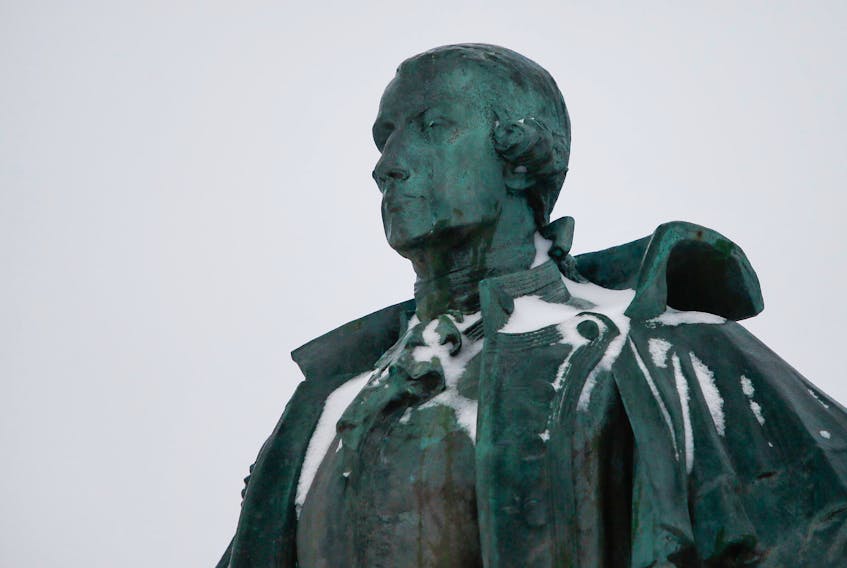Historical facts of yore appear to be subject to a range of “interpretations” these days, including Indigenous and non-Indigenous versions.
As Mi’kmaw Elder and historian Daniel N. Paul makes clear in his March 30 online response to our March 16 commentary, “Did the Mi’kmaq surrender?,” “… I want to correct a few factual errors that were included in their (Deveau/Canfield) article.”
But first let’s clarify the gist of our commentary. The focus was the mission/direction of the regrouped/renamed “task force” on the commemoration of Edward Cornwallis (covering his tenure as governor from 1749 to 1752) and Indigenous history, while encouraging all task force members (including Daniel Paul) to bring an “open mind” to their deliberations.
Regarding the “factual corrections:”
- Did the Mi’kmaq surrender? “They did not!” according to Paul. This is understandably a sensitive issue for the Mi’kmaq, particularly as it relates to their “unceded territory” position. However, as we outlined, it depends on how one interprets the British-Mi’kmaw peace and friendship treaties of the 1700s and follow-on agreements. In the spirit of reconciliation, many Nova Scotians acknowledge their presence on the traditional ancestral lands of the Mi’kmaq in what today is Nova Scotia. But what is considered ceded and unceded is quite another matter and requires more fact-based deliberation and understanding.
- The statement, “…to end a war (between the Mi’kmaq and British) that had lasted for approximately 130 years” is a bit of a stretch if it refers to Nova Scotia, since significant conflict between the two sides didn’t really start until after the signing of the Treaty of Utrecht (1713) whereby France ceded the Nova Scotia mainland to the British but retained Île Royale (present-day Cape Breton), aided by the Mi’kmaq who supported the French cause till the Treaty of Paris in 1763.
- Reference to bounty proclamations issued by Massachusetts Governor William Shirley (1744), Governor Cornwallis (1749) and Governor Charles Lawrence (1756) requires more historical context of time and place, including intent. Paul is light on providing an “all sides” background that led to the respective proclamations, especially Lt.-Gov. (not Gov., as stated) Paul Mascarene’s role in defending Annapolis Royal against French/Mi’kmaw forces, as well as Cornwallis’s efforts at defending the settlers at Halifax. Regarding the latter, the 1749 proclamation is open to interpretation, but needs to be viewed in its historical context; for example, the proclamation refers to “his” scalp which implies the bounty applied to a Mi’kmaw male, i.e. warrior; women and children are not mentioned (though they are mentioned in Lawrence’s proclamation, but only in terms of a bounty paid for prisoners). Last, Paul’s earlier charges of “genocide” against Cornwallis must ultimately be based on verifiable documentation on the number of scalps turned in at Halifax. As those familiar with records depicting the pressure Cornwallis was under to explain where the allocated government funds were going for the new settlement will attest, there were very little funds, if any, being paid for scalps.
- Regarding the statement attributed to Cornwallis “…it would be better to root the Micmac out of the peninsula decisively and forever,” one must also consider Cornwallis’s approach in March 1750, “… to harass and hunt the Mi’kmaq … until they had either to abandon the Peninsula or come in upon any (treaty) terms we please.” As the historical records indicate, three native raids on the Halifax-Dartmouth settlers were reported in 1750, followed by three more in 1751 (including the “Dartmouth Massacre” of May 13, 1751), no doubt prompting Cornwallis to explore a peace initiative. He would ultimately rescind the bounty proclamation in 1752 before resigning as governor.
As indicated in our March 16 commentary, let’s continue the important conversation of our collective past with an open mind and stick to what the historical documents reveal about the judgments and actions of the principal players of the time. A vivid imagination that presumes what happened is optional.
Leo J. Deveau and Len Canfield are members of the Halifax Military Heritage Preservation Society.
RELATED:









